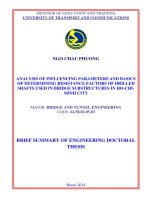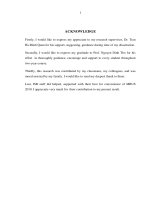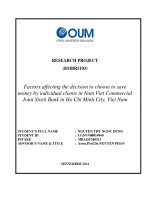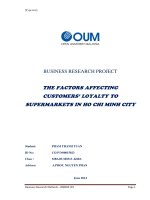Factors affecting logistics providers’ satisfaction with logistic environment in Ho Chi Minh city
Bạn đang xem bản rút gọn của tài liệu. Xem và tải ngay bản đầy đủ của tài liệu tại đây (625.42 KB, 16 trang )
68 | Bùi Thanh Tráng | 68 – 83
Factors Affecting Logistics Providers’ Satisfaction
Factors Affecting Logistics Providers’ Satisfaction
with Logistic Environment in Ho Chi Minh City
BÙI THANH TRÁNG
Doctor of philosophy, University of Economics HCMC
Email:
HỒ XUÂN TIẾN
HCMC College of Economics
Email:
ABSTRACT
The paper investigates factors affecting logistics providers’ satisfaction with
HCMC logistic environment and then extend some remedies to enhance it. By using
both quantitative and qualitative methods, the authors investigate 200 logistics
providers operating in HCMC. The results show that the satisfaction with the logistic
environment is affected by six factors: (1) the quality of trade- and transport-related
infrastructure, (2) the ease of arranging competitively priced shipments, (3) the
efficiency of the customs clearance process, (4) the ability to track and trace
consignments, (5) the competence and quality of logistic services , and (6) the
frequency with which shipments reach the consignee within the scheduled or expected
delivery time.
Keywords: satisfaction, logistic environment, HCMC-based logistics providers
JED No.216 April 2013 | 69
1. RATIONALE
Vietnam, a country in the Southeast Asia, is endowed with a strategic location for
international shipment which is facilitated by a long coastline and deep-sea ports. It
possesses a great potential for development of logistic services which play a crucial
role in the national economy and contribute a lot to the GDP. Logistics not only
stimulates the development of thousands of domestic enterprises but also promotes the
process of economic integration and commercial collaboration. It plays a crucial role in
tackling input and output problems effectively; optimizing the circulation of materials,
commodities and services; and thereby reducing costs and enhancing the enterprise’s
competitiveness.
Logistics is the spine of global commerce. An efficient logistic environment will
increase economic growth. An appropriate policy and strategy is necessary to improve
the logistic environment, which in turn will pave the way for the strong development
of Vietnam’s logistic service and its contribution to national socioeconomic
development. Therefore, investigating factors affecting the satisfaction of HCMCbased logistics providers with logistic environment will help improve the logistic
environment and Vietnam’s logistics quality.
2. THEORETICAL FRAMEWORK AND RESEARCH MODEL
a. Logistics and Logistics Performance Index (LPI):
According to the American Logistics Association (1988), logistics is the process of
planning, organizing and managing the transport and storage of consignments or
services between the point of origin and the point of destination in order to meet some
requirements of customers. In Vietnam, it first appeared in the 1970s. Logistic services
are a kind of commercial activity, in which a provider organizes one or many tasks
simultaneously including acceptance of consignment, shipment, warehousing, customs
clearance, consultancy, packaging, coding, delivery and other services in accordance
with agreements with customers to enjoy a remuneration (Commercial Law, 2005).
In order to evaluate the logistics performance of a country, the Logistics
Performance Index (LPI) introduced by the World Bank is often employed (World
Bank, 2007, 2010, 2012). LPI was first publicized in November 2007 and second in
January 2010, third in May 2012 in a series of Connecting to Compete: Trade Logistics
in the Global Economy. LPI is studied and measured by economists of the World Bank
70 | Bùi Thanh Tráng | 68 – 83
Factors Affecting Logistics Providers’ Satisfaction
in collaboration with various international organizations, world big logistics providers
and other academic partners.
As published in editions 2007 and 2010 by World Bank, LPI is composed of six
factors:
- The efficiency of the customs clearance – hereunder called Customs.
- The quality of trade- and transport-related infrastructure – hereunder called
Infrastructure.
- The ease of arranging competitively priced shipments – hereunder called
International shipments.
- The competence and quality of logistic services – hereunder called Logistics
quality and competence.
- The ability to track and trace consignments – hereunder called Tracking and
tracing.
- The frequency with which shipments reach the consignee within the scheduled or
expected delivery time – hereunder called Timeliness.
b. An Overview of the Logistic Environment and Logistics Providers in
Vietnam:
Since Vietnam’s accession to the WTO, its logistics market has made positive
changes and the number of logistics providers has continuously risen. The annual
revenue approximates US$12 billion. According to World Bank, Vietnam, in 2011,
was ranked 53rd out of 155 countries in terms of LPI. With regard to the Liner
Shipping Connectivity Index (LSCI) by the United Nations Conference on Trade and
Development (UNCTAD), Vietnam was ranked 20th out of 162 countries in 2012, a
stable rise in past years. These figures show that Vietnam’s logistics performance is
moderate, which is an optimistic sign for Vietnam’s logistics in upcoming years,
especially when Vietnam builds deep-sea ports.
However, in the process of economic integration and at the regional level,
Vietnam’s logistics has exposed plenty of weakness in infrastructure, seaports,
warehouses, logistics providers’ competence, and especially high-quality human
resources. Albeit plenty of investments have been poured in infrastructure, they are
scattered and thus cannot establish a logistic hub with a convenient traffic network
serving the development of logistics. Consequently, the asynchronous development of
JED No.216 April 2013 | 71
roads, railways, waterways, and airways, etc. has pushed Vietnam’s logistics costs
higher than those of neighboring countries and represented 25% of GDP; and thereby
spoiling the competitiveness of domestic logistic services. Therefore, it is necessary to
develop seaports, wharves, freight yards, warehouses, inland clearance depots (ICD);
invest in loaders and heavy equipment machines to load and transport commodities
within the seaport, from ICDs to seaports and vice versa; and utilize IT breakthroughs
effectively.
Development of logistics must be parallel with the development of shipping and
containerization so as to meet customers’ requirements quickly, safely, and efficiently.
Seaports should be expanded and modernized in order to be able to accommodate
container ships and keep up with the development of shipping industry in the world.
The project of maritime transport development to 2020 approved by Vietnam’s
government also indicates that logistic services must be emphasized in parallel with the
promotion of high-quality multiple modes of transportation services and then 3PL and
4PL services which can be provided across the border to meet integration
requirements.
At present, there are 1,143 logistics providers, according to the statistics of
Vietnam’s Yellow and White Pages. Of them, limited liabilities companies account for
19%, joint stock ones 19%, and private ones 2%. In HCMC alone, there are
approximately 700 logistics providers. Albeit multinationals of this field are few, their
market share is large, and the annual revenue is very high. In the meantime,
Vietnamese firms, despite being more numerous than foreign ones, earn low revenue.
According to Vietnam’s Logistics Association, logistics providers are often granted a
business term of five years at least. Majority of them are small-sized; and those with a
capital smaller than VND1 billion represent 78%, from VND1 billion to smaller than
VND5 billion making up 15%, from VND5 billion to VND10 billion being 4% and
more than VND10 billion constituting around 3%. Due to the fact that the capital size
is small, firms cannot acquire equipment and employ high-qualified human resources;
and thus the service quality is inconsistent, professionalism is low, competitiveness is
weak, and IT competence cannot keep up with other devel��������������������������������������������������������������������������������������������������������������������������������������������������������������������������������������������������������������������������������������������������������������������������������������������������������������������������������������������������������������������������������������������������������������������������������������������������������������������������������������������������������������������������������������������������������������������������������������������������������������������������������������������������������������������������������������������������������������������������������������������������������������������������������������������������������������������������������������������������������������������������������������������������������������������������������������������������������������������������������������������������������������������������������������������������������������������������������������������������������������������������������������������������������������������������������������������������������������������������������������������������������������������������������������������������������������������������������������������������������������������������������������������������������������������������������������������������������������������������������������������������������������������������������������������������������������������������������������������������������������������������������������������������������������������������������������������������������������������������������������������������������������������������������������������������������������������������������������������������������������������������������������������������������������������������������������������������������������������������������������������������������������������������������������������������������������������������������������������������������������������������������������������������������������������������������������������������������������������������������������������������������������������������������������������������������������������������������������������������������������������������������������������������������������������������������������������������������������������������������������������������������������������������������������������������������������������������������������������������������������������������������������������������������������������������������������������������������������������������������������������������������������������������������������������������������������������������������������������������������������������������������������������������������������������������������������������������������������������������������������������������������������������������������������������������������������������������������������������������������������������������������������������������������������������������������������������������������������������������������������������������������������������������������������������������������������������������������������������������������������������������������������������������������������������������������������������������������������������������������������������������������������������������������������������������������������������������������������������������������������������������������������������������������������������������������������������������������������������������������������������������������������������������������������������������������������������������������������������������������������������������������������������������������������������������������������������������������������������������������������������������������������������������������������������������������������������������������������������������������������������������������������������������������������������������������������������������������������������������������������������������������������������������������������������������������������������������������������������������������������������������������������������������������������������������������������������������������������������������������������������������������������������������������������������������������������������������������������������������������������������������������������������������������������������������������������������������������������������������������������������������������������������������������������������������������������������������������������������������������������������������������������������������������������������������������������������������������������������������������������������������������������������������������������������������������������������������������������������������������������������������������������������������������������������������������������������������������������������������������������������������������������������������������������������������������������������������������������������������������������������������������������������������������������������������������������������������������������������������������������������������������������������������������������������������������������������������������������������������������������������������������������������������������������������������������������������������������������������������������������������������������������������������������������������������������������������������������������������������������������������������������������������������������������������������������������������������������������������������������������������������������������������������������������������������������������������������������������������������������������������������������������������������������������������������������������������������������������������������������������������������������������������������������������������������������������������������������������������������������������������������������������������������������������������������������������������������������������������������������������������������������������������������������������������������������������������������������������������������������������������������������������������������������������������������������������������������������������������������������������������������������������������������������������������������������������������������������������������������������������������������������������������������������������������������������������������������������������������������������������������������������������������������������������������������������������������������������������������������������������������������������������������������������������������������������������������������������������������������������������������������������������������������������������������������������������������������������������������������������������������������������������������������������������������������������������������������������������������������������������������������������������������������������������������������������������������������������������������������������������������������������������������������������������������������������������������������������������������������������������������������������������������������������������������������������������������������������������������������������������������������������������������������������������������������������������������������������������������������������������������������������������������������������������������������������������������������������������������������������������������������������������������������������������������������������������������������������������������������������������������������������������������������������������������������������������������������������������������������������������������������������������������������������������������������������������������������������������������������������������������������������������������������������nd measurement scales can measure various research concepts.
As the matrix of correlation coefficients indicates, the “infrastructure” has the strongest
impacts on the dependent variable.
Table 2: EFA Results
Variable
Descriptions
Factors
CS
CS1
E-customs declarations
are quick.
0.743
CS2
Customs offices often
hold customs talks.
0.781
CS3
Changes in duty rates are
immediately notified to
enterprises.
0.741
Term of customs
clearance for imports is
appropriate.
0.761
CS4
IF
IS
TL
LC
TT
SAS
JED No.216 April 2013 | 77
CS5
Term of customs
clearance for exports is
short.
0.776
No corruption is found
during the customs
clearance.
0.632
CS7
The ratio of customs
check is appropriate.
0.706
CS8
Customs dossiers
submitted to customs
bureaus are few.
0.707
CS6
IF1
IF2
IF3
IF4
IF5
IS1
IS3
IS4
Equipment of the
seaports is always
available.
0.789
The location of seaports
is convenient to
transportation.
0.833
It is convenient to
transport commodities
by ferries.
0.801
The roadways leading to
seaports are through and
in good conditions.
0.804
IT applications are
effectively employed to
operate the seaport.
0.788
The capacity of shippers
meets the customers’
need.
0.677
Maritime logistics
providers are numerous
and diverse.
0.689
There are direct transport
routines to the European
0.759
78 | Bùi Thanh Tráng | 68 – 83
Factors Affecting Logistics Providers’ Satisfaction
market.
IS5
IS6
TL1
TL2
TL3
TL4
It is easy to arrange
competitively priced
shipments.
0.745
There are direct transport
routines to the North
American market.
0.702
Shipments reach the port
of destination within the
scheduled or expected
delivery time.
0.773
Commodities are
transported exactly as
notified
0.719
There is no
postponement of
departure date.
0.750
There are few incidents
concerning maritime
transport.
0.619
LC1
Logistic costs are
competitive.
0.615
LC2
Competence and
professionalism of
logistics staff meets
customers’ needs.
0.683
LC3
Loss of consignments
has never occurred.
0.761
LC4
Bylaws of logistics
operation are manifest.
0.722
TT3
Software used to track
and trace consignments
provide adequate
information.
0.660
JED No.216 April 2013 | 79
TT4
TT5
TT6
Information of accidents
is notified to the
provider in time.
0.661
It is easy to require
logistic information from
service providers.
0.733
Logistics providers
regularly notify
customers of the
consignments’ status.
0.740
SAS1
I am satisfied with the
logistic environment.
0.940
SAS2
I am pleased with the
provided logistic
services.
0.929
I believe in the strong
development of
Vietnam’s logistics.
0.866
SAS3
Eigenvalues
13.647
2.104
1.840
1.422
1.302
1.135
2.498
Extracted variance (%)
18.224
14.018
11.741
9.396
9.096
9.023
83.276
Source: EFA results based on surveyed data
Table 3: Matrix of Correlation Coefficients
CS
IF
IS
TL
LC
TT
SAS
1
0.000
0.000
0.000
0.000
0.000
0.411**
Infrastructure (IF)
0.000
1
0.000
0.000
0.000
0.000
0.668**
International shipments (IS)
0.000
0.000
1
0.000
0.000
0.000
0.654**
Timeliness (TL)
0.000
0.000
0.000
1
0.000
0.000
0.285**
0.000
0.000
0.000
0.000
1
0.000
0.227**
0.000
0.000
0.000
0.000
0.000
1
0.354**
Customs (CS)
Logistics
quality
competence (LC)
Tracking and tracing (TT)
and
80 | Bùi Thanh Tráng | 68 – 83
Satisfaction (SAS)
Factors Affecting Logistics Providers’ Satisfaction
0.411**
0.668** 0.654** 0.285**
0.227** 0.354**
1
** denotes the statistically significant level at 10%; N = 200
Source: Correlation analysis results based on surveyed data
Table 4: Linear Regression Results
Unstandardized Standardized
coefficients
coefficients
Multicollinearity
t
B
Standard
deviation
Customs (CS)
0.316
0.035
0.301
Infrastructure (IF)
0.563
0.035
International shipment (IS)
0.452
Timeliness (TL)
Sig.
Tolerance
VIF
9.075 0.000
0.562
1.657
0.512
16.140 0.000
0.893
1.895
0.045
0.421
12.971 0.000
0.832
1.703
0.183
0.035
0.102
5.249 0.000
0.632
1.432
Logistics quality and
competence (LC)
0.223
0.042
0.197
6.407 0.000
0.735
1.341
Tracking and tracing (TT)
0.248
0.037
0.217
7.102 0.000
0.802
1.235
Source: Regression analysis results based on surveyed data
The Enter method is employed to analyze the multiple linear regression of factors
affecting the logistic environment satisfaction. Table 4 shows that the relationship of
six influential factors namely Customs (CS), Infrastructure (IF), International shipment
(IS), Logistics competence and quality (LC), Tracking and tracing (TT), and
Timeliness (TL) with the logistic environment satisfaction by logistics providers has
the significance value smaller than 0.05. The adjusted R2 is 0.758, and thus the
goodness of fit of the multiple linear regression model reaches 75.8%; or in other
words, 75.8% of the logistic environment satisfaction is affected by six stated factors
while the remaining (24.2%) is influenced by other factors. The low tolerance and the
VIF smaller than 2 prove that no multicollinearity is found and there is no close
correlation among independent variables. Therefore, it can be concluded that the
regression model fits the data set and variables are statistically significant at the 5%
JED No.216 April 2013 | 81
level. Hypotheses 1 to 6 are acceptable. The linear regression model can be written as
follows:
Y = 0.316* X1 + 0.563* X2 + 0.452* X3 + 0.183* X4 + 0.223* X5+ 0.248* X6
Where, Y denotes the logistic environment satisfaction by logistics providers; X1 is
Customs, X2 is Infrastructure, X3 is International shipment; X4 is Timeliness, X5 is
Logistics competence and quality, and X6 is Tracking and Tracing.
5. CONCLUSION AND SUGGESTIONS
As the paper indicates, there are six factors affecting satisfaction of HCMC-based
logistics providers with logistic environment; and the influential level for each factor is
different.
- Infrastructure (IF) has the strongest impacts on the satisfaction, with the regression
coefficient of 0.563.
- International shipment (IS) has the regression coefficient of 0.452.
- The regression coefficient of Customs (CS) is 0.316.
- The regression coefficient of Tracking and tracing (TT) is 0.248.
- The regression coefficient of Logistics quality and competence (LC) is 0.223.
- The regression coefficient of Timeliness (TL) is 0.183.
According to the aforementioned analyses, the quality of trade- and transportrelated infrastructure has the strongest impact on the satisfaction with the logistic
environment, and the efficiency of the customs clearance is ranked third. The findings
are congruent with LPI ranking of World Bank (2007, 2009, 2012), which states that
the quality of trade- and transport-related infrastructure and the efficiency of the
customs clearance are two greatest concern in low- or average-income countries.
Based on research findings, it is advised that:
Firstly, the roadway system should be upgraded to meet the increasing demand for
transport in HCMC. The infrastructure of seaports in the Eastern South region should
be developed in parallel to the development of roadways, railways, airways and
waterways to assure the smooth transportation of consignments. Besides, it is an urgent
need to move local seaports along the Saigon River to Cát Lái, Hiệp Phước and Cái
Mép – Thị Vải to reduce the transport pressure in the inner city. Moreover, it is
necessary to adopt preferential tax policies and enable enterprises to invest in the
82 | Bùi Thanh Tráng | 68 – 83
Factors Affecting Logistics Providers’ Satisfaction
inner-city waterway system so as to make the best use of natural advantages of river
system in HCMC.
Secondly, a state-of-the-art fleet of container ships should be developed to meet the
need of maritime transport and fleets of small vessels for local transport (i.e. 500 –
2,000 TEU vessels for Asian routes, and 2000 – 6000 TEU vessels for European and
American routes). However, the development of a fleet of container ships must be
parallel with its competitiveness in order to be able to compete with foreign ones and
avoid a massive acquisition of vessels without gaining large market share.
Thirdly, the Prime Minister’s Decision 48/2011/QĐ-TTg dated Aug. 31, 2011
concerning the pilot execution of a national one-door customs regime must be
stringently observed. Accordingly, by 2014, the term of customs clearance for imports
and exports would be one day for air transport and 2.6 days for maritime transport. In
addition, customs formalities should be reformed to facilitate the quick and effective
customs clearance for imports and exports.
Finally, logistics providers should invest in IT and employ dedicated software to
facilitate the business and transaction with both local and foreign customers. IT is an
urgent requirement: it not only helps track the consignment status but also settle etransaction documents. Logistics providers should enhance the professional
competence of their staff and open IT training courses to boost the competitiveness.
6. LIMITATIONS AND SUGGESTIONS FOR FURTHER RESEARCH
Albeit the paper has extended certain contributions in terms of theory and practice, there are
some limitations. Due to the fact that samples are chosen conveniently, the generalization is
restricted. Moreover, the measurement scales are only measured by the Cronbach’s Alpha and
EFA; and the theoretical model is tested by correlation coefficients and the multiple linear
regression analyses. Thus, it is advised to test the theoretical model by other methods such as
SEM which can both test hypotheses and determine the causality of research concepts
References
Đăng Quang (2010), “Hiện trạng cảng container TP.HCM và vùng phụ cận - Một cập nhật cho các
doanh nghiệp xuất nhập khẩu và hãng tàu”, Vietnam Shipper, Vol.67, pp.38-42, Vol.68, pp.3437, Vol.69, pp.40-42.
Đoàn Thị Hồng Vân & Kim Ngọc Đạt (2010), Logistics - Những vấn đề cơ bản, Lao động- Xã hội
Publisher, Hà Nội.
JED No.216 April 2013 | 83
Hair, J.F., R.E. Anderson, R.L. Tatham & W.C. Black (1998), Multivariate Data Analysis, New
Jersey: Prentice-Hall.
Narin Phol (2010), “3PL View on New Trends in Supply Chain Management”, proceedings of
Vietnam Logso Exhibition 2010 held by Vietnam Supply Chain Insight Magazine on 29/7/2010.
Nguyễn Hùng (2012), “Logistics Việt Nam: 5 năm sau WTO (2007-2012)”, Vietnam Shipper,
Vol.53, 19.
Nguyễn Hùng (2011), “Logistics Việt Nam bước qua thời kỳ non trẻ”, Vietnam Logistics Review,
Vol.49, pp.8-10.
Nunnally, J. & I.H. Bernstein (1994), Psychometric Theory, 3rd Ed., New York: McGraw-Hill.
Parasuraman, A, V.A. Zeithaml & L.L. Berry (1988), "SERVQUAL: A Multi-item Scale for
Measuring Consumer Perceptions of Service Quality", Journal of Retailing, Vol 64(1), pp.1237.
Parasuraman, A., V.A. Zeithaml & L.L. Berry (1985), “A Conceptual Model of Service Quality and
Its Implications for Future Research”, Journal of Marketing, Vol.49(4), pp.41-50.
Thanh Long (2012), “Yếu logistics– Doanh nghiệp xuất khẩu gặp khó”, Vietnam Shipper, Vol.1, pp.
40- 41.
Vietnam’s National Assembly (2005), Commercial Law.
World Bank (2007, 2010, 2012), Connecting to Compete - Trade Logistics in the Global Economy.









